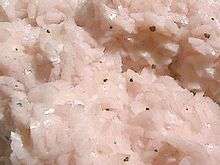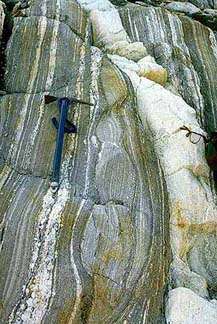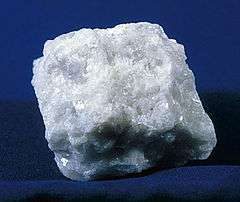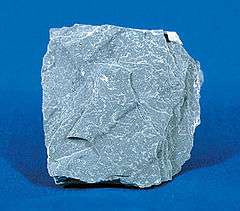List of rock types
The following is a list of rock types recognized by petrologists. There is no agreed number of specific types of rocks. Any unique combination of chemical composition, mineralogy, grain size, texture, or other distinguishing characteristics can describe rock types. Additionally, different classification systems exist for each major type of rock. There are three major types of rock, sedimentary, metamorphic, and igneous. They are all identified by their texture, streak, and location, among other factors..
Igneous
- Adakite - a class of intermediate to felsic rocks containing low amounts of yttrium and ytterbium

- Andesite - an intermediate volcanic rock
- Alkali feldspar granite - a granitoid in which at least 90% of the total feldspar is in the form of alkali feldspar
- Anorthosite - a mafic intrusive igneous rock composed predominantly of plagioclase
- Aplite - a very fine-grained intrusive igneous rock composed of quartz and feldspar, similar composition to granite but with grains <1mm
- Basalt - a volcanic rock of mafic composition
- Basanite - a volcanic rock of mafic composition; essentially a silica-undersaturated basalt
- Blairmorite - a rare volcanic rock
- Boninite - a magnesium-rich basalt dominated by pyroxene
- Carbonatite - a rare igneous rock composed of >50% carbonate minerals
- Charnockite - a type of granite containing orthopyroxene
- Enderbite - a variety of charnockite
- Dacite - a felsic to intermediate volcanic rock containing hornblende and with more plagioclase than orthoclase
- Diabase or dolerite - an intrusive mafic rock forming dykes or sills
- Diorite - a coarse-grained intermediate plutonic rock composed of plagioclase, pyroxene and/or amphibole
- Napoleonite - a variety of diorite which is characterized by orbicular structure. Also called corsite.
- Dunite - a phaneritic ultramafic rock composed of more than 90% olivine
- Essexite - a silica-undersaturated mafic plutonic rock (essentially a feldspathoid-bearing gabbro)
- Foidolite - a plutonic igneous rock composed of >90% feldspathoid minerals
- Gabbro - a coarse-grained plutonic rock composed of pyroxene and plagioclase basically equivalent to basalt
- Granite - a coarse-grained plutonic rock composed of orthoclase, plagioclase and quartz
- Granodiorite - a granitic plutonic rock with more plagioclase than orthoclase
- Granophyre - a subvolcanic intrusive rock of granitic composition
- Harzburgite - a variety of peridotite; an ultramafic cumulate rock
- Hornblendite - a mafic or ultramafic cumulate rock dominated by >90% hornblende
- Hyaloclastite - a volcanic rock composed primarily of glasses and glassy tuff
- Icelandite - an iron-rich, aluminium-poor andesite
- Ignimbrite - a fragmental volcanic rock
- Ijolite - a very rare silica-undersaturated plutonic rock
- Kimberlite - a rare ultramafic, ultrapotassic volcanic rock and a source of diamonds
- Komatiite - an ultramafic volcanic rock with very high magnesium content
- Lamproite - an ultrapotassic volcanic rock
- Lamprophyre - an ultramafic, ultrapotassic intrusive rock dominated by mafic phenocrysts in a feldspar groundmass
- Latite - a silica-undersaturated form of andesite
- Lherzolite - an ultramafic rock, essentially a peridotite
- Monzogranite - a silica-undersaturated granite with <5% normative quartz
- Monzonite - a plutonic rock with <5% normative quartz
- Nepheline syenite - a silica-undersaturated plutonic rock of nepheline and alkali feldspar
- Nephelinite - a silica-undersaturated plutonic rock with >90% nepheline
- Norite - a hypersthene-bearing gabbro
- Obsidian - a type of volcanic glass
- Pegmatite - an igneous rock (or metamorphic) rock with crystals >1 inch, usually granitic
- Peridotite - a plutonic or cumulate ultramafic rock composed of olivine and pyroxene
- Phonolite - a silica-undersaturated volcanic rock; essentially similar to nepheline syenite
- Picrite - an olivine-bearing basalt
- Porphyry - a rock, usually granitic, with a porphyritic texture
- Pumice - a fine grained, vesicular volcanic rock
- Pyroxenite - a coarse grained plutonic rock composed of >90% pyroxene
- Quartz diorite - a diorite with >5% modal quartz
- Quartz monzonite - an intermediate plutonic rock, essentially a monzonite with 5-10% modal quartz
- Quartzolite - an intrusive rock composed mostly of quartz
- Rhyodacite - a felsic volcanic rock which is intermediate between a rhyolite and a dacite
- Rhyolite - a felsic volcanic rock
- Comendite - a peralkaline rhyolite
- Pantellerite - an alkaline rhyolite-rhyodacite with amphibole phenocrysts
- Scoria - an extremely vesicular mafic volcanic rock
- Sovite - a coarse-grained carbonatite rock
- Syenite - a plutonic rock dominated by orthoclase feldspar; a type of granitoid
- Tachylyte - essentially a basaltic glass
- Tephrite - a silica-undersaturated volcanic rock
- Tonalite - a plagioclase-dominant granitoid
- Trachyandesite - an alkaline intermediate volcanic rock
- Benmoreite - sodic trachyandesite
- Basaltic trachyandesite
- Mugearite - sodic basaltic trachyandesite
- Shoshonite - potassic basaltic trachyandesite
- Trachyte - a silica-undersaturated volcanic rock; essentially a feldspathoid-bearing rhyolite
- Troctolite - a plutonic ultramafic rock containing olivine, pyroxene and plagioclase
- Trondhjemite - a form of tonalite where plagioclase-group feldspar is oligoclase
- Tuff - a fine-grained volcanic rock formed from volcanic ash
- Websterite - a type of pyroxenite, composed of clinoproxene and orthopyroxene
- Wehrlite - an ultramafic plutonic or cumulate rock, a type of peridotite, composed of olivine and clinopyroxene
Sedimentary


- Argillite - a sedimentary rock composed primarily of clay-sized particles
- Arkose - a sandstone with <25% feldspar crystals
- Banded iron formation - a fine-grained chemical sedimentary rock composed of iron oxide minerals
- Breccia - a sedimentary or tectonic rock composed of fragments of other, broken rocks
- Calcarenite - a sedimentary rock composed of > 50% detrital carbonate grains
- Chalk - a sedimentary rock composed primarily of coccolith fossils
- Chert - a fine-grained chemical sedimentary rock composed of silica
- Claystone - a sedimentary rock formed from clay
- Coal - a sedimentary rock formed from organic matter
- Conglomerate - a sedimentary rock composed of large rounded fragments of other rocks
- Coquina - a sedimentary carbonate rock formed by accumulation of abundant shell fossils and fragments
- Diamictite - a lithified sedimentary deposit with a wide range of grain sizes
- Diatomite - sedimentary rock formed from diatom fossils
- Dolomite or dolostone - a carbonate rock composed of the mineral dolomite +/- calcite
- Evaporite - chemical sedimentary rock formed by accumulation of minerals after evaporation; varieties include rock salt (halitite) and rock gypsum
- Flint - a form of chert
- Geyserite - opaline silica deposit formed around hot springs and geysers
- Greywacke - a type of sandstone with quartz, feldspar and rock fragments within a clay matrix
- Gritstone - essentially a coarse sandstone formed from small pebbles
- Itacolumite - porous, yellow-orange sandstone which is flexible if cut into thin strips
- Jaspillite - an iron-rich chemical sedimentary rock similar to chert or banded iron formation
- Laterite - residual sedimentary rock formed from a parent rock under tropical conditions
- Lignite - sedimentary rock composed of 60%- 70% organic material; otherwise known as brown coal
- Limestone - composed primarily of carbonate minerals
- Marl - limestone with a considerable proportion of silicate material
- Mudstone - clastic sedimentary rock that contains a mixture of silt- and clay-sized particles
- Oil shale - sedimentary rock composed dominantly of organic material
- Oolite - chemical sedimentary limestone formed from ooids, spherical grains composed of concentric layers
- Sandstone - clastic sedimentary rock defined by its grain size (0.0625 mm to 2 mm)
- Shale - clastic, fissile sedimentary rock defined by clay-sized particles
- Siltstone - clastic sedimentary rock defined by 50% or greater silt-sized particles
- Tillite - lithified glacial till
- Travertine - sedimentary rock containing calcite and iron oxides
- Tufa - porous limestone formed by the precipitation of carbonate minerals from ambient temperature water bodies
- Turbidite - particular sequence of sedimentary rocks which form within the deep ocean environment
- Wackestone - matrix-supported carbonate sedimentary rock.
Metamorphic






- Anthracite - metamorphosed coal, between 92% - 98% organic matter
- Amphibolite - a metamorphic rock composed primarily of amphibole
- Blueschist - a metamorphic rock composed of sodic amphiboles with a distinct blue color
- Cataclasite - a rock formed by faulting
- Eclogite - an ultra-high grade metamorphosed basalt or gabbro; also a facies of metamorphic rocks
- Gneiss - a high grade coarse grained metamorphic rock with light and dark alternating bands
- Granulite - a high grade metamorphic rock formed from basalt; also a facies of metamorphic rocks
- Greenschist - a mafic metamorphic rock dominated by green amphiboles
- Hornfels - a metamorphic rock formed by heating by an igneous rock
- Litchfieldite - nepheline syenite gneiss
- Marble - a metamorphosed limestone
- Migmatite - a high grade metamorphic rock verging upon melting into a magma
- Mylonite - a metamorphic rock formed by shearing
- Metapelite - a metamorphic rock with a protolith of clay-rich (siltstone) sedimentary rock
- Metapsammite - a metamorphic rock with a protolith of quartz-rich (sandstone) sedimentary rock
- Phyllite - a low grade metamorphic rock composed mostly of micaceous minerals
- Pseudotachylite - a glass formed by melting within a fault via friction
- Quartzite - a metamorphosed sandstone typically composed of >95% quartz
- Schist - a low to medium grade metamorphic rock
- Serpentinite - a metamorphosed ultramafic rock dominated by serpentine minerals
- Skarn - a metasomatic rock
- Slate - a low grade metamorphic rock formed from shale or silts
- Suevite - a rock formed by partial melting during a meteorite impact
- Talc carbonate - a metamorphosed ultramafic rock with talc as an essential constituent; similar to a serpentinite
- Whiteschist - a high pressure metamorphic rock containing talc and kyanite
Specific varieties of rocks
The following are terms for rocks that are not petrographically or genetically distinct but are defined according to various other criteria; most are specific classes of other rocks, or altered versions of existing rocks. Some archaic and vernacular terms for rocks are also included.
- Adamellite - a variety of quartz monzonite
- Appinite - a group of varieties of lamprophyre, mostly rich in hornblende
- Aphanite - an aphanitic felsic volcanic rock which confounds identification via optical means
- Borolanite - a variety of nepheline syenite from Loch Borralan, Scotland
- Blue Granite - essentially larvikite, a monzonite
- Epidosite - a type of metasomatite; essentially altered basalt
- Felsite - an aphanitic felsic volcanic rock which confounds identification via optical means
- Flint - typically a form of chert, jasper, or tuff
- Ganister - a Cornish term for a lithified E horizon of a palaeosol formed from sandy soil
- Gossan - the product of the weathering of a sulfide rock or ore body
- Hyaloclastite – volcanic glass with basaltic composition
- Ijolite - a silica-undersaturated plutonic rock associated with nepheline syenites
- Jadeitite - a very rare rock formed by concentration of jadeite pyroxene; a form of serpentinite
- Jasperoid - a hematite-silica metasomatite analogous to a skarn
- Kenyte - a variety of phonolite, first found on Mount Kenya
- Lapis lazuli - a rock composed of lazulite and other minerals
- Larvikite - a variety of monzonite with microperthitic ternary feldspars from Larvik, Norway
- Litchfieldite - a metamorphosed nepheline syenite occurrence near Litchfield, Maine
- Llanite - a hypabyssal rhyolite with microcline and blue quartz phenocrysts from the Llano Uplift in Texas
- Luxullianite - a tourmaline-bearing granite with a peculiar texture, occurring at Luxulyan, Cornwall, England
- Mangerite - a hypersthene-bearing monzonite
- Minette - a variety of lamprophyre
- Novaculite - a type of chert found in Oklahoma, Arkansas and Texas
- Pyrolite - a chemical analogue considered to theoretically represent the earth's upper mantle
- Rapakivi granite - a granite containing crystals of orthoclase, which are mantled by oligoclase
- Rhomb porphyry - a type of latite with euhedral rhombic phenocrysts of feldspar
- Shonkinite - melitilic and kalsititic rocks
- Taconite - banded iron formation, primarily used in the United States of America
- Tachylite - basaltic volcanic glass
- Teschenite - a silica undersaturated, analcime bearing gabbro
- Theralite - a nepheline gabbro
- Unakite - an altered granite
- Variolite - devitrified glass
- Vogesite - a variety of lamprophyre
- Wad - rock rich in manganese oxide or manganese hydroxide
See also
- List of minerals
- List of rocks on Mars
- Rock cycle
- Rock formation: for a list of unusual or culturally significant rock outcrops.
- Leaverite
External links
- British Geological Survey rock classification scheme
- Igneous rock classification
- Rock Types Article by Encyclopædia Britannica
- Classification of common rocks and soils
- Metamorphic Rock Classification
- Volcanic rocks
- Earth Science Education Unit virtual rock kit